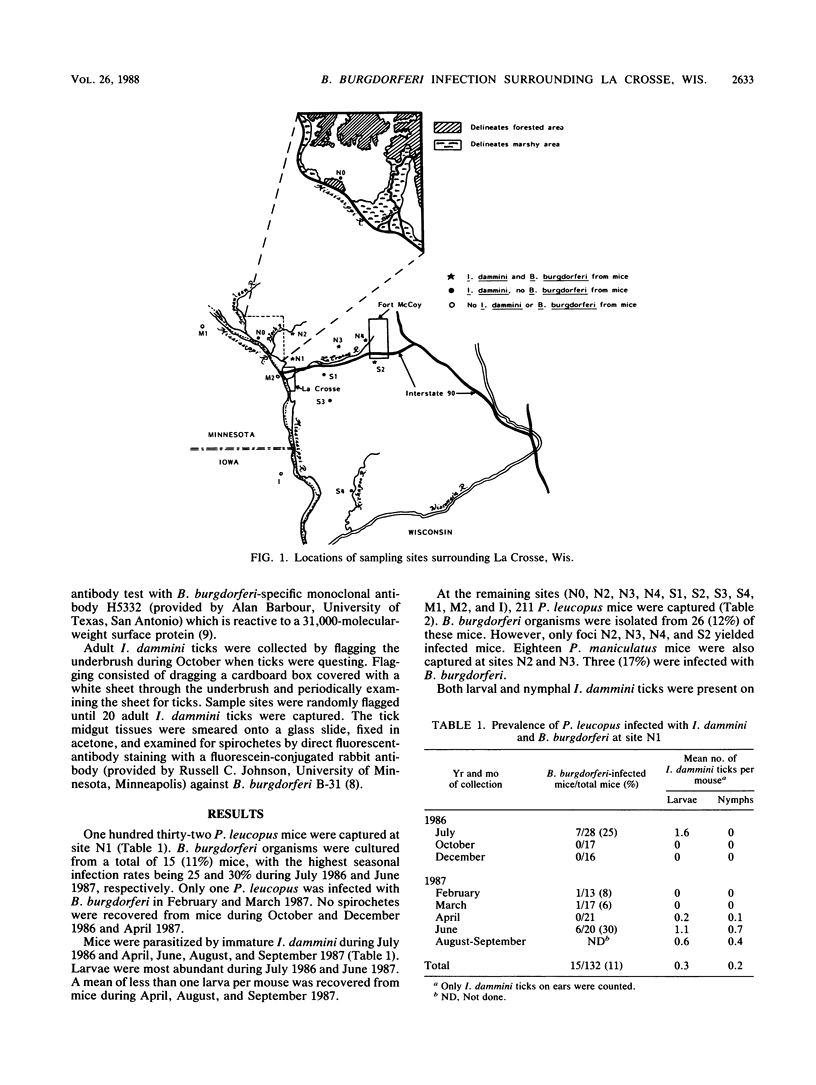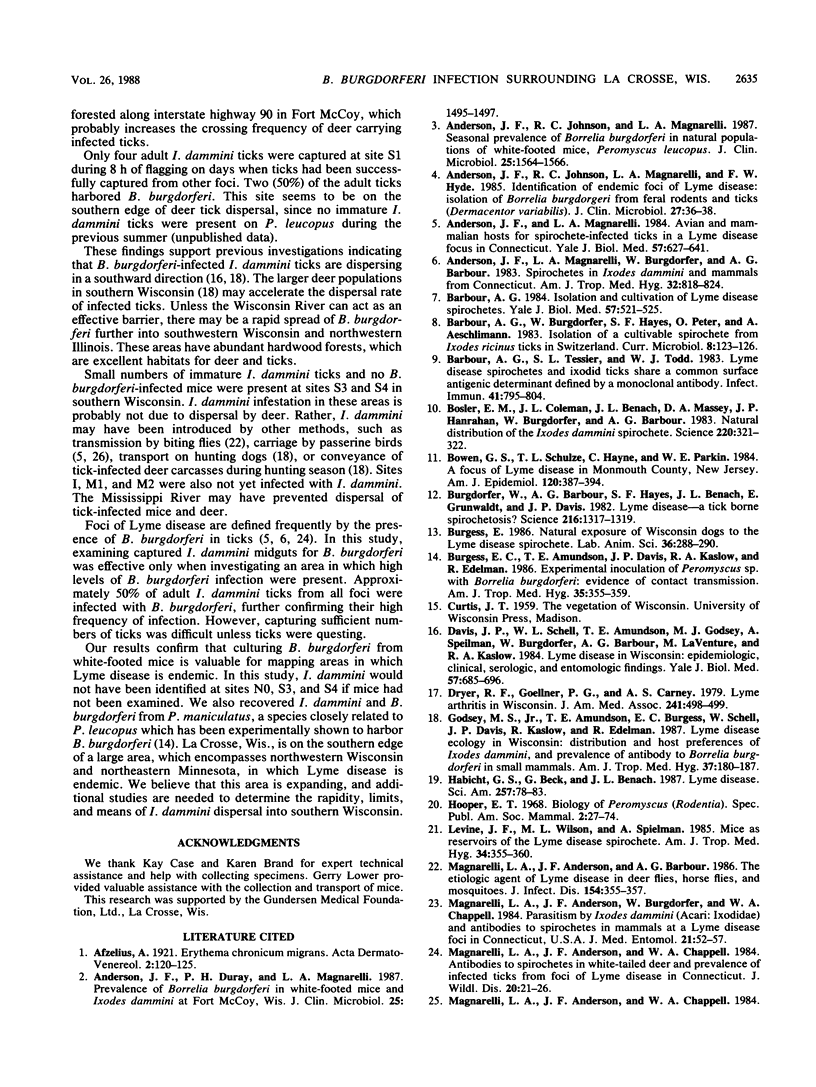Abstract
This investigation defined the extent of Borrelia burgdorferi infection surrounding La Crosse, Wis. White-footed mice, Peromyscus leucopus or P. maniculatis, were captured from sites in Wisconsin, Minnesota, and Iowa and cultured for B. burgdorferi to define the local boundaries of the midwestern Lyme disease area. All foci of B. burgdorferi infection (N1, N2, N3, and N4) were located north of interstate highway 90 except focus S2, which was south of the highway near Fort McCoy, Wis. The interstate highway may have been a barrier to deer movement which slowed the southward dispersal of Ixodes dammini. B. burgdorferi was isolated from 12 (63%) of the mice captured from site N4, which was adjacent to the western border of Fort McCoy. Unexpectedly, no B. burgdorferi-infected mice were isolated at site N0, located north of interstate highway 90 and enclosed by areas in which B. burgdorferi infection is endemic. This site is surrounded by natural barriers which may have slowed the spread of I. dammini by deer. The Wisconsin area in which B. burgdorferi is endemic should now include the surrounding area north of interstate highway 90 west from Fort McCoy to the Mississippi River. Additional studies are needed to define the rapidity, limits, and means of I. dammini dispersal into southern Wisconsin.
Full text
PDF




Selected References
These references are in PubMed. This may not be the complete list of references from this article.
- Anderson J. F., Duray P. H., Magnarelli L. A. Prevalence of Borrelia burgdorferi in white-footed mice and Ixodes dammini at Fort McCoy, Wis. J Clin Microbiol. 1987 Aug;25(8):1495–1497. doi: 10.1128/jcm.25.8.1495-1497.1987. [DOI] [PMC free article] [PubMed] [Google Scholar]
- Anderson J. F., Johnson R. C., Magnarelli L. A., Hyde F. W. Identification of endemic foci of Lyme disease: isolation of Borrelia burgdorferi from feral rodents and ticks (Dermacentor variabilis). J Clin Microbiol. 1985 Jul;22(1):36–38. doi: 10.1128/jcm.22.1.36-38.1985. [DOI] [PMC free article] [PubMed] [Google Scholar]
- Anderson J. F., Johnson R. C., Magnarelli L. A. Seasonal prevalence of Borrelia burgdorferi in natural populations of white-footed mice, Peromyscus leucopus. J Clin Microbiol. 1987 Aug;25(8):1564–1566. doi: 10.1128/jcm.25.8.1564-1566.1987. [DOI] [PMC free article] [PubMed] [Google Scholar]
- Anderson J. F., Magnarelli L. A. Avian and mammalian hosts for spirochete-infected ticks and insects in a Lyme disease focus in Connecticut. Yale J Biol Med. 1984 Jul-Aug;57(4):627–641. [PMC free article] [PubMed] [Google Scholar]
- Anderson J. F., Magnarelli L. A., Burgdorfer W., Barbour A. G. Spirochetes in Ixodes dammini and mammals from Connecticut. Am J Trop Med Hyg. 1983 Jul;32(4):818–824. doi: 10.4269/ajtmh.1983.32.818. [DOI] [PubMed] [Google Scholar]
- Barbour A. G. Isolation and cultivation of Lyme disease spirochetes. Yale J Biol Med. 1984 Jul-Aug;57(4):521–525. [PMC free article] [PubMed] [Google Scholar]
- Barbour A. G., Tessier S. L., Todd W. J. Lyme disease spirochetes and ixodid tick spirochetes share a common surface antigenic determinant defined by a monoclonal antibody. Infect Immun. 1983 Aug;41(2):795–804. doi: 10.1128/iai.41.2.795-804.1983. [DOI] [PMC free article] [PubMed] [Google Scholar]
- Bosler E. M., Coleman J. L., Benach J. L., Massey D. A., Hanrahan J. P., Burgdorfer W., Barbour A. G. Natural Distribution of the Ixodes dammini spirochete. Science. 1983 Apr 15;220(4594):321–322. doi: 10.1126/science.6836274. [DOI] [PubMed] [Google Scholar]
- Bowen G. S., Schulze T. L., Hayne C., Parkin W. E. A focus of Lyme disease in Monmouth County, New Jersey. Am J Epidemiol. 1984 Sep;120(3):387–394. doi: 10.1093/oxfordjournals.aje.a113903. [DOI] [PubMed] [Google Scholar]
- Burgdorfer W., Barbour A. G., Hayes S. F., Benach J. L., Grunwaldt E., Davis J. P. Lyme disease-a tick-borne spirochetosis? Science. 1982 Jun 18;216(4552):1317–1319. doi: 10.1126/science.7043737. [DOI] [PubMed] [Google Scholar]
- Burgess E. C., Amundson T. E., Davis J. P., Kaslow R. A., Edelman R. Experimental inoculation of Peromyscus spp. with Borrelia burgdorferi: evidence of contact transmission. Am J Trop Med Hyg. 1986 Mar;35(2):355–359. doi: 10.4269/ajtmh.1986.35.355. [DOI] [PubMed] [Google Scholar]
- Burgess E. C. Natural exposure of Wisconsin dogs to the Lyme disease spirochete (Borrelia burgdorferi). Lab Anim Sci. 1986 Jun;36(3):288–290. [PubMed] [Google Scholar]
- Davis J. P., Schell W. L., Amundson T. E., Godsey M. S., Jr, Spielman A., Burgdorfer W., Barbour A. G., LaVenture M., Kaslow R. A. Lyme disease in Wisconsin: epidemiologic, clinical, serologic, and entomologic findings. Yale J Biol Med. 1984 Jul-Aug;57(4):685–696. [PMC free article] [PubMed] [Google Scholar]
- Dryer R. F., Goellner P. G., Carney A. S. Lyme arthritis in Wisconsin. JAMA. 1979 Feb 2;241(5):498–499. [PubMed] [Google Scholar]
- Godsey M. S., Jr, Amundson T. E., Burgess E. C., Schell W., Davis J. P., Kaslow R., Edelman R. Lyme disease ecology in Wisconsin: distribution and host preferences of Ixodes dammini, and prevalence of antibody to Borrelia burgdorferi in small mammals. Am J Trop Med Hyg. 1987 Jul;37(1):180–187. doi: 10.4269/ajtmh.1987.37.180. [DOI] [PubMed] [Google Scholar]
- Levine J. F., Wilson M. L., Spielman A. Mice as reservoirs of the Lyme disease spirochete. Am J Trop Med Hyg. 1985 Mar;34(2):355–360. doi: 10.4269/ajtmh.1985.34.355. [DOI] [PubMed] [Google Scholar]
- Magnarelli L. A., Anderson J. F., Barbour A. G. The etiologic agent of Lyme disease in deer flies, horse flies, and mosquitoes. J Infect Dis. 1986 Aug;154(2):355–358. doi: 10.1093/infdis/154.2.355. [DOI] [PubMed] [Google Scholar]
- Magnarelli L. A., Anderson J. F., Burgdorfer W., Chappell W. A. Parasitism by Ixodes dammini (Acari: Ixodidae) and antibodies to spirochetes in mammals at Lyme disease foci in Connecticut, USA. J Med Entomol. 1984 Jan 26;21(1):52–57. doi: 10.1093/jmedent/21.1.52. [DOI] [PubMed] [Google Scholar]
- Magnarelli L. A., Anderson J. F., Chappell W. A. Antibodies to spirochetes in white-tailed deer and prevalence of infected ticks from foci of Lyme disease in Connecticut. J Wildl Dis. 1984 Jan;20(1):21–26. doi: 10.7589/0090-3558-20.1.21. [DOI] [PubMed] [Google Scholar]
- Main A. J., Carey A. B., Carey M. G., Goodwin R. H. Immature Ixodes dammini (acari: Ixodidae) on small animals in Connecticut, USA. J Med Entomol. 1982 Nov 30;19(6):655–664. doi: 10.1093/jmedent/19.6.655. [DOI] [PubMed] [Google Scholar]
- Scrimenti R. J. Erythema chronicum migrans. Arch Dermatol. 1970 Jul;102(1):104–105. [PubMed] [Google Scholar]
- Spielman A., Clifford C. M., Piesman J., Corwin M. D. Human babesiosis on Nantucket Island, USA: description of the vector, Ixodes (Ixodes) dammini, n. sp. (Acarina: Ixodidae). J Med Entomol. 1979 Mar 23;15(3):218–234. doi: 10.1093/jmedent/15.3.218. [DOI] [PubMed] [Google Scholar]
- Spielman A., Wilson M. L., Levine J. F., Piesman J. Ecology of Ixodes dammini-borne human babesiosis and Lyme disease. Annu Rev Entomol. 1985;30:439–460. doi: 10.1146/annurev.en.30.010185.002255. [DOI] [PubMed] [Google Scholar]
- Steere A. C., Grodzicki R. L., Kornblatt A. N., Craft J. E., Barbour A. G., Burgdorfer W., Schmid G. P., Johnson E., Malawista S. E. The spirochetal etiology of Lyme disease. N Engl J Med. 1983 Mar 31;308(13):733–740. doi: 10.1056/NEJM198303313081301. [DOI] [PubMed] [Google Scholar]
- Steere A. C., Malawista S. E., Snydman D. R., Shope R. E., Andiman W. A., Ross M. R., Steele F. M. Lyme arthritis: an epidemic of oligoarticular arthritis in children and adults in three connecticut communities. Arthritis Rheum. 1977 Jan-Feb;20(1):7–17. doi: 10.1002/art.1780200102. [DOI] [PubMed] [Google Scholar]


